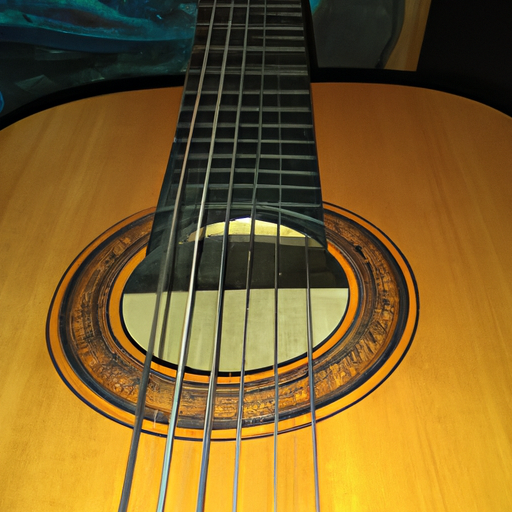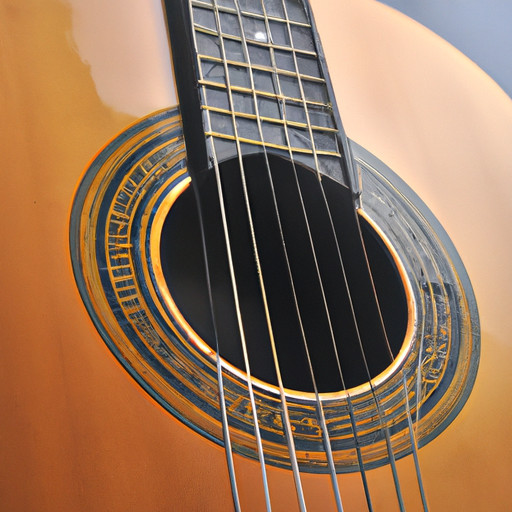
The acoustic guitar is one of the most popular musical instruments in the world. It is loved by musicians of all genres and skill levels. This instrument produces sound by transmitting the vibrations of its strings to the air, creating a rich and warm tone. The acoustic guitar has a long and fascinating history, dating back centuries.

The acoustic guitar has its roots in ancient civilizations such as the Egyptians, Greeks, and Romans. However, it wasn't until the 16th century that we saw the modern form of the guitar emerge. It was during this time that the guitar was introduced to Europe, where it gained popularity among the aristocracy.

Over the years, the design and construction of the acoustic guitar have evolved. Today, we have various types and styles of acoustic guitars, each with its own unique sound and characteristics.
To understand how an acoustic guitar works and produces sound, it's essential to familiarize yourself with its different parts.
The main parts of an acoustic guitar include the body, neck, fretboard, headstock, tuning pegs, bridge, and strings.
Each part of an acoustic guitar plays a crucial role in producing its unique sound.
By understanding the different parts of the guitar and how they contribute to its sound, players can make informed choices when selecting an acoustic guitar that suits their preferences.
Choosing the right acoustic guitar can be an overwhelming task, especially for beginners. It's crucial to consider several factors before making a purchase.
There are several types of acoustic guitars available, each with its own pros and cons.
The dreadnought is the most common type of acoustic guitar. It has a large body and a full, rich sound. Dreadnought guitars are versatile and suitable for various genres, making them a popular choice for beginners.
Concert guitars have a smaller body size compared to dreadnoughts. They offer a balanced tone and are comfortable to play, making them ideal for fingerpicking and solo performances.
Auditorium guitars are slightly larger than concert guitars. They produce a well-balanced sound and are suitable for both strumming and fingerpicking. Auditorium guitars are a versatile choice for players who want a balanced tone with good projection.
Jumbo guitars have an even larger body size than dreadnoughts. They produce a deep, booming sound and are ideal for players who prefer a powerful and bass-heavy tone. Jumbo guitars are commonly used in country and folk music.
It's important to try out different types of acoustic guitars to find the one that feels comfortable and produces the desired sound for your playing style.
Before diving into playing the acoustic guitar, it's crucial to tune it properly. Tuning ensures that the strings are at the correct pitch, allowing you to play in tune with other instruments or recordings.
Tuning your guitar is essential for several reasons:
There are several methods you can use to tune your guitar:
Guitar tuners are small electronic devices that detect the pitch of each string and indicate whether it's too high, too low, or in tune. Simply pluck each string and adjust the tuning pegs until the tuner indicates that the string is in tune.
If you have access to a piano or keyboard, you can use it to tune your guitar. Start by finding the corresponding notes on the piano for each open string of the guitar. Pluck the string and match the pitch to the corresponding piano key.
Harmonics are produced by lightly touching the strings at specific points and plucking them. By comparing the harmonics of two strings, you can adjust the tuning of one string to match the other.
Experiment with different tuning methods and find the one that works best for you. It's important to check your guitar's tuning regularly, as the strings can go out of tune due to temperature changes, humidity, or regular playing.
Learning basic chords and strumming patterns is essential for beginners on their acoustic guitar journey.
Here are some of the most common chords used in acoustic guitar playing:
These chords form the foundation for many songs in various genres. Practice transitioning between these chords smoothly to build your chord vocabulary.
Once you're comfortable with basic chords, you can start practicing strumming patterns. Here are a few easy patterns to get you started:
Practice these strumming patterns slowly at first, focusing on accuracy and timing. As you become more comfortable, increase the speed and experiment with different patterns to create your unique sound.
Fingerpicking is a technique that involves plucking the strings of the guitar with your fingers instead of using a pick. It creates a melodic and intricate sound and is commonly used in folk, blues, and classical guitar styles.
Here are some common fingerpicking techniques to explore:
Start with simple fingerpicking exercises to develop coordination and finger independence. As you become more comfortable, practice playing fingerstyle arrangements of your favorite songs.
Rhythm guitar playing is the backbone of any band or musical ensemble. It provides the foundation and supports the melody and other instruments.
Rhythm guitar playing involves strumming or picking chords in a rhythmic pattern to create a steady beat. It helps define the overall groove and feel of a song, allowing other musicians to play their parts effectively.
Rhythm guitar is important in a band because:
Here are some tips to help you improve your rhythm guitar skills:
Remember, rhythm guitar playing is not just about playing the right chords at the right time; it's about feeling the music and creating a cohesive and tight sound with the rest of the band.
Lead guitar playing involves playing melodies, solos, and improvising over chord progressions. It's a more melodic and expressive role within a band.
Lead guitar players take the spotlight and play the main melodies, solos, and improvisations in a song. They add excitement, emotion, and virtuosity to the music.
Lead guitar is important in a band because:
Here are some essential techniques for playing lead guitar:
To become a proficient lead guitarist, practice scales, learn solos from your favorite guitarists, and experiment with different techniques and phrasing.
The acoustic guitar is a fantastic tool for songwriting. Its versatility and portability make it an ideal instrument for creating melodies, chord progressions, and lyrics.
Here are some steps to help you write songs using the acoustic guitar:
Remember, songwriting is a creative process, so don't be afraid to experiment, take risks, and let your emotions guide you.
Proper care and maintenance are essential to keep your acoustic guitar in optimal playing condition.
Here are some tips for caring for your acoustic guitar:
Here are some common problems you may encounter with your acoustic guitar and how to troubleshoot them:
Regular maintenance and addressing problems promptly will ensure that your acoustic guitar stays in top playing condition for years to come.
Learning to play the acoustic guitar is a rewarding journey that requires dedication, practice, and a love for music. Whether you're a beginner or an experienced player, this step-by-step guide provides a solid foundation for your acoustic guitar playing. Remember to have fun, be patient, and let your creativity shine through your music.
Click here for more information on hiring a band or finding musical instruments for your next event.